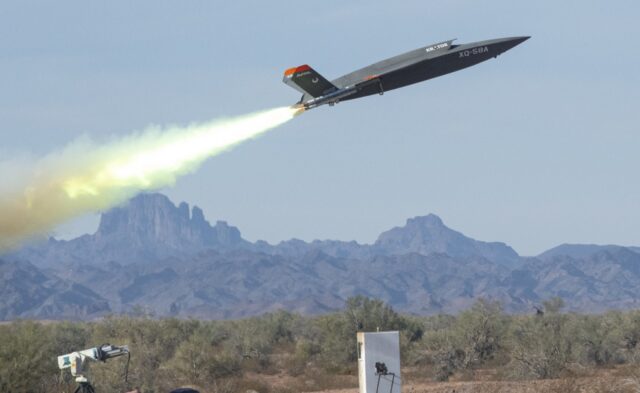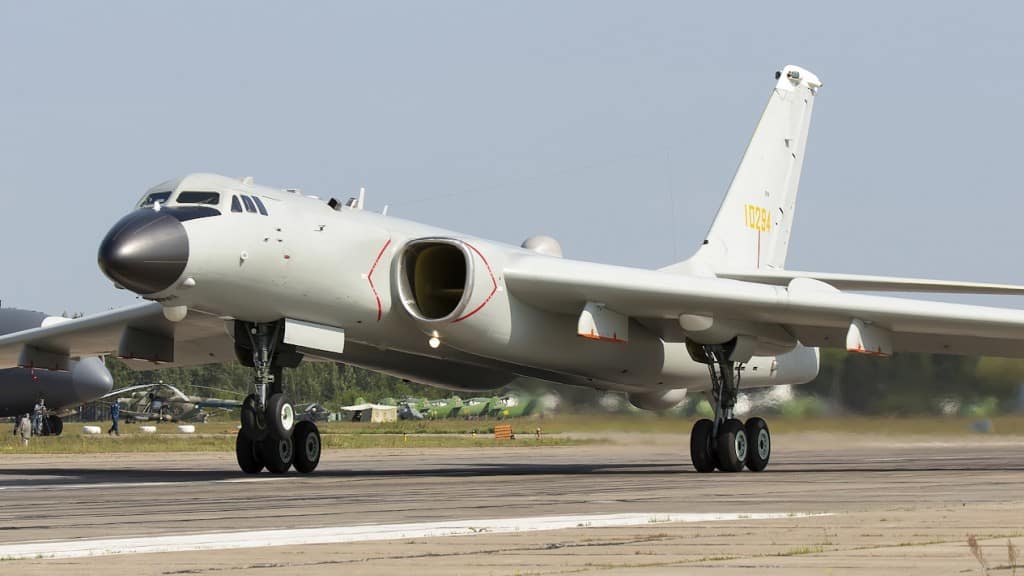Some interesting information related to Chinese bombers and unmanned aerial vehicles has surfaced around the recently completed 20th Congress of the Communist Party of China. This convergence, of course, is not accidental, Xi Jinping had to show progress in the modernization of aviation. Among other things, there were reports on the next possible date for the H-20 presentation. On the other hand, more specific information revealed the successful launch of the LJ-1 drones carried by the H-6K.
Xi’an H-20 is called the Chinese equivalent of the American B-21 Raider. There is a lot of exaggeration in this comparison – the H-20 will be rather a technological equivalent of the B-2. On the other hand, Americans are also raising the bar for propaganda. Northrop Grumman recently identified the B-21 as the first sixth generation combat aircraft.
The American bomber already exists in metal, or at least is materializing (presentation is scheduled for December 2). The H-20, on the other hand, remains elusive. The first flight was announced at the turn of 2018 and 2019, then it was talked about 2020. The Pentagon is quite skeptical about the pace of work on a new Chinese bomber. A 2020 Chinese military report to Congress said such a machine may not enter service in the current decade.
Chinese state-run media has dropped a strong hint that the first flight of the country’s next-generation stealth bomber “Xian H-20”, could be imminent. pic.twitter.com/Ac83p7R5I6
– Mujahid Ahmed-🦅 (@CallSignMujahid) July 11, 2022
The case returned in July this year when Ge Heping, party cell chief at the China Aviation Research Center, announced a test flight of a plane of “critical strategic and historical importance.” The speculation was heated by a press conference of the Air Force of the People’s Liberation Army on 27 September. Asked by journalists whether there will be a new plane at the Zhuhai show in November, aviation spokesman Major Colonel Shen Jinke announced a demonstration of new developments in the field of “strategic long-range means of conveyance” along with equipment that the public had “never seen before.”
Of course, the H-20 comes to mind, but there are many buts. Aviation Week’s Steve Trimble points out that in China, fairs and shows are not used to debut new aircraft. First, there are always unofficial photos and official announcements. The J-20 fighter was flown in 2011 and has been a media hero since then, but it was not shown to a wider audience in Zhuhai until 2016. The same can be said about the heavy Y-20 transport plane or the PL-15 long-range air-to-air missile .
So maybe Colonel Shen wasn’t after the H-20 at all? The term “Strategic Long Range Means” is very broad. According to Trimble, it may be a Y-20U (YU-20) flying tanker. Although the plane had its public debut in August this year at the Changchun air show, it is a much smaller event than the world-famous Zhuhai. The Y-20 and H-20 come from the same design office of the Xi’an aerospace plant, and the flying tanker is an important means of supporting long-range bomber operations.
YU-20 refueling J-20 # aviation #AvGeek pic.twitter.com/pIzr3xwoz1
– Erik Valensvek 🇬🇧🇨🇳 (@EK_Valensvek) September 27, 2022
H-6K and drones
H-20 is most likely a song of the distant future. Chinese long-range aviation has to do what it has, which means relying on the Xi’an H-6 bombers. This is a very old design derived from the Tu-16 flown in 1952. However, as in the case of the B-52, the newest H-6N and H-6K with the first versions only have the airframe shell in common. These aircraft are designed to be carriers of cruise missiles, and in the case of the H-6N also air ballistic and hypersonic missiles.
In the first half of October – the exact date is unknown – the Chinese state television CCTV-7 aired interesting material. It shows the H-6K carrying and releasing four LJ-1 unmanned aerial vehicles during the flight. It is only a computer animation, but it shows where the thoughts of the Chinese aviation command, or at least the aviation companies, are running.
H-6K drops multiple drones pic.twitter.com/EaQ9Hh2Cx8
– 彩云 香江 (@louischeung_hk) October 12, 2022
For years, China has been placing great emphasis on the development of unmanned systems and artificial intelligence. Nevertheless, among the numerous more or less autonomous projects, both capable of operating in a swarm and not, there was little information about the loyal wingman. This concept, which is gaining more and more popularity, assumes the introduction of relatively cheap multi-role drones to the service, cooperating with manned aircraft. Loyal wingers are faced with a wide range of tasks, including reconnaissance, attacks on ground targets and radio-electronic combat. More forward-looking ideas also include air combat.
In the context of a loyal wingman, the J-20 fighter is most often mentioned. Last year, the first reliable photos of the two-seater version of the J-20B appeared, which is most likely to act as an air command center for drones. At last year’s Zhuhai showroom, the CASC FH-97 was presented, giving the impression of the American XQ-58A Valkyrie clone. The design was quickly linked to the design of a loyal wingman for the J-20. It is also known that the FH-97 has numerous competitors.

The XQ-58A – the work of Kratos Defense & Security Solutions, flown on March 5, 2019 – is to be a low-cost solution capable of operating both as a loyal wingman and as a fully autonomous combat agent.
(US Air Force / Staff Sgt. Joshua King)
But the LJ-1 is not one of them. In China, as in the USA, the concept of simple drones accompanying airplanes has emerged. It is already known that the price of loyal wingers will be slightly lower than that of manned machines. In short, advanced drones will be too valuable to lose. Therefore, we need simpler UAVs, with limited capabilities, but cheap and possible to use in large numbers.
Developed by a small aviation company CCKW and the North-East University of Technology (NWPU) from Xi’an LJ-1 in its original version, it was a training target. Interestingly, it premiered in 2019 at the Moscow MAKS air show. It was presented as a reusable target, capable of flying at high and low altitudes at high subsonic speeds, and also capable of maneuvering with high overloads. The LJ-1 was to imitate third and fourth generation fighters, although there were suggestions for more advanced machines, and the developers themselves emphasized the modular design.
Here is the clue of the program and the reason why the LJ-1 could be useful for bombers. Mission modules (not known or interchangeable) can turn the drone into a reconnaissance machine, allowing planes to see further. CCKW and NWPU also indicate the possibility of using drones to defend the H-6 family aircraft, but do not provide details. It is possible to equip the LJ-1 with flares and foil strips ejectors, and ultimately the collection of projectiles. Such a configuration would not be anything new. In 2003, the Americans used BQM-34 Firebee flying targets to spread foil strips and thus confuse Iraqi air defense.
Speaking of J-6s, the PLA’s Eastern Theater Command recently released photos showing the PLAAF’s J-6 unmanned aircraft conversion. Blurred serials suggest active service; at least 50 can be seen in @planet imagery from September at 1 of 2 bases known to be operating the type pic.twitter.com/HvvMrpnjtB
– Mike Yeo 杨启铭 (@TheBaseLeg) October 20, 2021
The LJ-1 can also probably be used in a swarm to distract air defense from bombers. As a cheap and relatively simple machine, it is very well suited for this. It is not the only Chinese drone intended for such tasks. It is known that several dozen old J-6 fighters, i.e. MiG-a-19 clones, have already been converted into unmanned aerial vehicles. Their concentration in Fujian Province clearly indicates the intention to use them against Taiwan.
Finally, the LJ-1 can probably be equipped with a warhead, turning it into a cruise missile. So it would be another weapon in the H-6K’s arsenal, all the more dangerous if it could operate in a swarm.
See also: Syria: The smaller Russia’s influence, the greater Iran’s influence
Andrei Shmatko, Creative Commons Attribution-Share Alike 4.0 International

